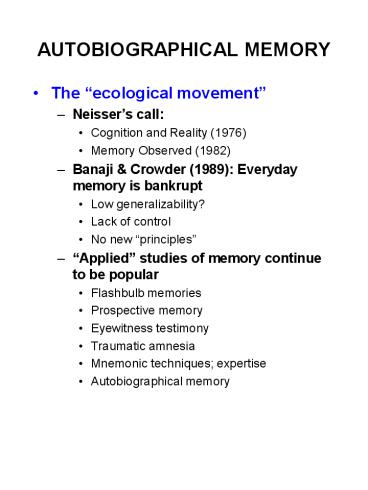AUTOBIOGRAPHICAL MEMORY
1 / 10
Title:
AUTOBIOGRAPHICAL MEMORY
Description:
Proust's In Search of Lost Time (1922) The importance of cues. Ecphory of the past and present ... Diary-based cued recall of AM. Wagenaar 1986. AM content and access ... –
Number of Views:143
Avg rating:3.0/5.0
Title: AUTOBIOGRAPHICAL MEMORY
1
AUTOBIOGRAPHICAL MEMORY
- The ecological movement
- Neissers call
- Cognition and Reality (1976)
- Memory Observed (1982)
- Banaji Crowder (1989) Everyday memory is
bankrupt - Low generalizability?
- Lack of control
- No new principles
- Applied studies of memory continue to be
popular - Flashbulb memories
- Prospective memory
- Eyewitness testimony
- Traumatic amnesia
- Mnemonic techniques expertise
- Autobiographical memory
2
Memory for Ones Life StoryContent and Process
- Biography and Culture
- Biography as historical record
- Biography as narrative
- The oral history movement
- AM as a social activity
- Building and sharing our life story
- Allendes Paula (1995)
- Socializing, bonding and constructing the self
through recounting our story - Prousts In Search of Lost Time (1922)
- The importance of cues
- Ecphory of the past and present
- Memory is life Rachel the Replicant
- The importance of reminiscence among the elderly
- Bluck In search of wisdom
- The adaptive functions of AM fight, flight or
flirt?
3
METHODS OF TESTINGAUTOBIOGRAPHICAL MEMORY
- Cuing methods
- Free recall (and problem of clustering)
- Cued recall
- By word or phrase (Galton 1879 Crovitz 1974)
- By date
- By life period
- Recognition (and issue of distractors)
- How to verify memory?
- Experimenters keeping diaries
- Linton (75), Wagenaar (86) record events and
contexts - Subjects keeping diaries
- Brewer (88) random moments
- Interviews with family members
- Repeated testing of individuals
4
STRUCTURE AND PROCESS IN AUTOBIOGRAPHICAL MEMORY
- The forgetting function for AM
- Strong recency effect
- Quasilinear or power function?
- Crovitz Schiffman, 1974
- Wagenaar, 1986
- Content and cuing variables
- Salience and emotionality
- Number and type of cuesData from Wagenaar, 1986
- Deviations from the curve
- Infantile amnesia and its causes
- The reminiscence bump 15-25 yrs
5
- Content of AM
- AM as composite of episodic (spatiotemporal
context) and semantic (personal and factual)
information - EM as fleeting, unless linked to AM knowledge
and context (Conway, 00) - EM (e.g., imagery) critical for cuing
- Linked to or part of the Self and goal
- Importance of self and goal hierarchy in Conways
recent work - Constructive nature
- 30 new details, 40 change in those called
distinctive, over retest (Anderson Conway,
94) - But also largely accurate
- Constraints on errors
- Rehearsal and stabilization of stories
6
- Organization of AM
- Conway Rubins hierarchical model
- Life Periods around Themes
- General Events and minihistories
- Event-specific Knowledge and details
7
- Retrieval of AM
- Retrieval as cyclic and effortful
- General events the typical entry point via cues
(cf. Roschs Basic Level?) - Top two levels accessed semantically
- ESK within events accessed chronologically?
- Free recall at first faster, then slower, than
chronological (Anderson Conway 93) - The pleasures of remembering
- Photos, scrapbooks and diaries
8
Crovitz Schiffman, 1974cue-word recall of AM
9
Wagenaar 1986Diary-based cued recall of AM
10
Wagenaar 1986AM content and access
Functions are Wagenaars ratings at time of
event, With 1 the lowest in all cases

